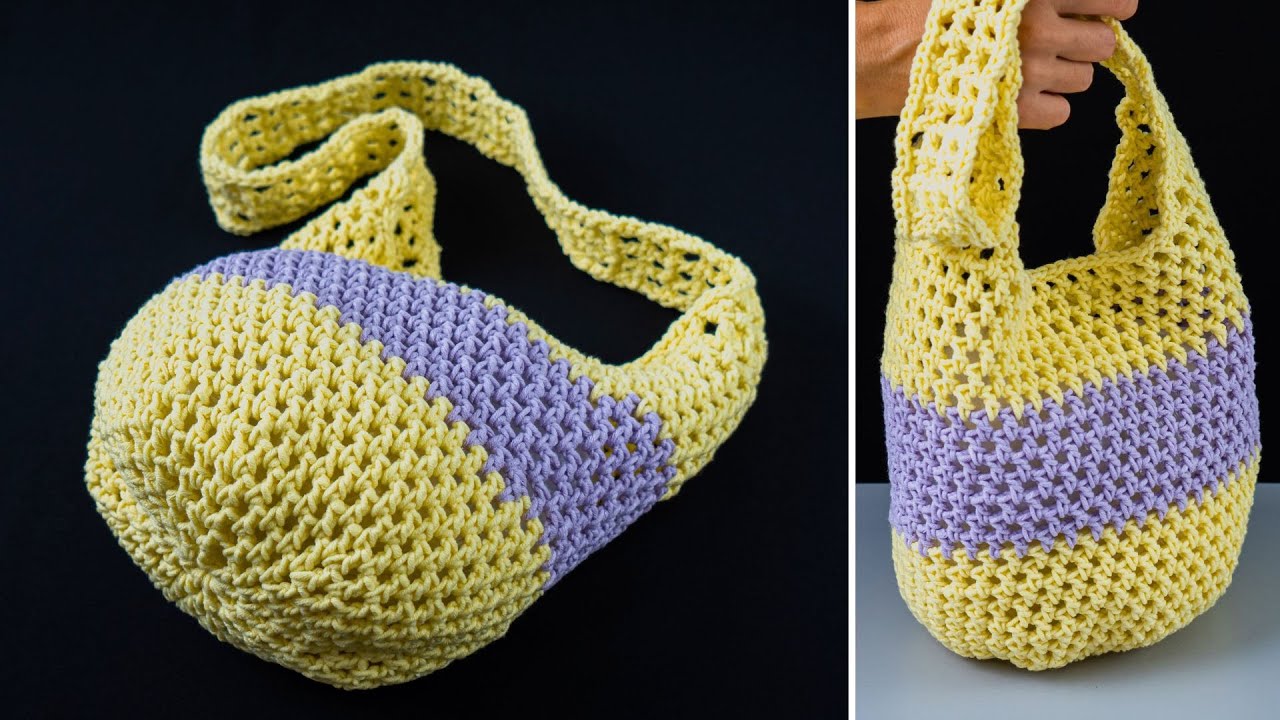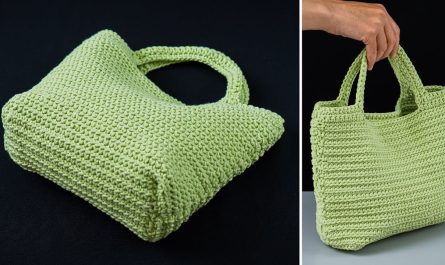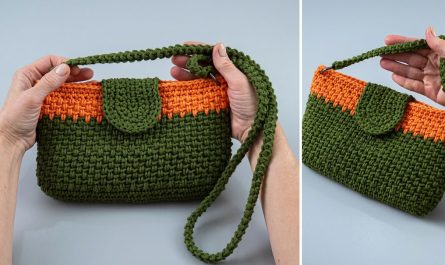Let’s crochet a versatile and eco-friendly easy net bag! This type of bag, often called a market bag or string bag, is perfect for groceries, beach essentials, or even just as a stylish, lightweight carry-all. It’s a fantastic project for beginners as it uses simple stitches and a repetitive pattern. Plus, it’s a great way to reduce single-use plastic!
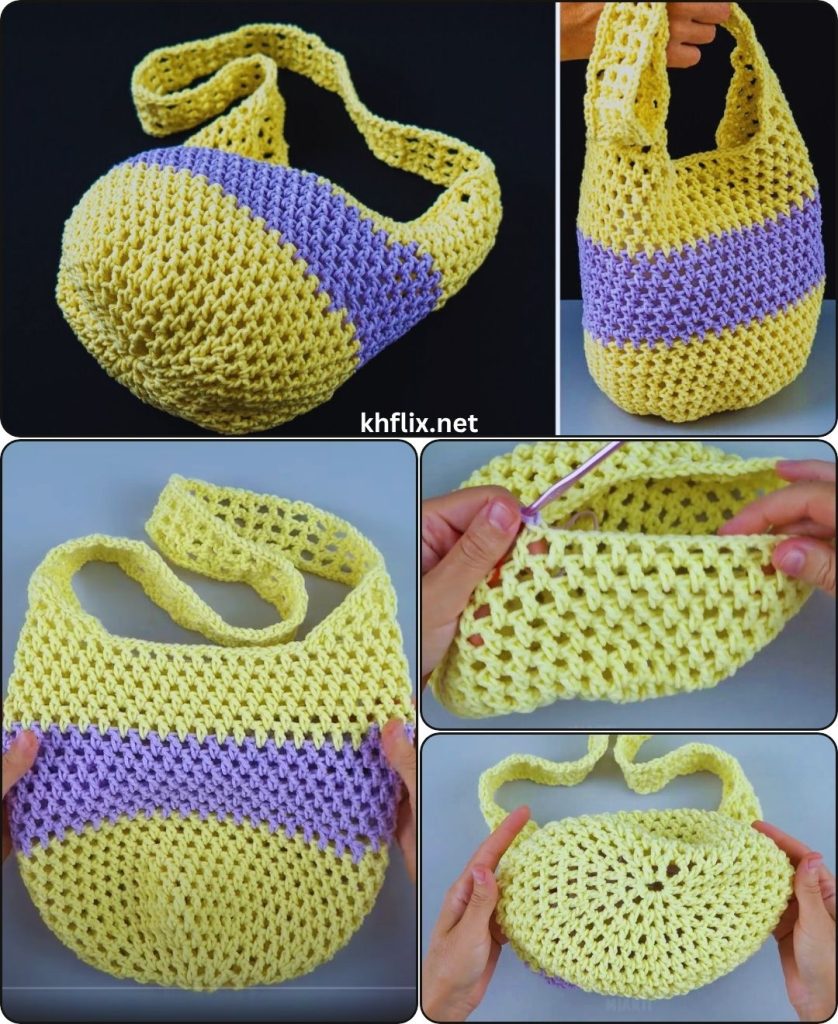
How to Crochet an Easy Net Bag (Step-by-Step Tutorial)
This detailed guide will take you through each stage of creating your net bag: building a solid base, working up the open mesh body, and adding sturdy handles.
Skill Level: Beginner
This project is perfect if you’re comfortable with (or ready to learn!):
- Chain (ch): The basic foundation.
- Slip Stitch (sl st): For joining rounds.
- Single Crochet (sc): A dense stitch, great for the base and handles.
- Double Crochet (dc): The main stitch for the mesh body.
- Working in rounds: Crocheting in a circular fashion.
- Fastening off: Securing your yarn.
- Weaving in ends: The essential finishing touch.
Finished Net Bag Dimensions (Approximate):
Using worsted weight cotton yarn and the suggested hook, your finished net bag will typically measure around:
- Base: 10 inches (25 cm) wide by 3 inches (7.5 cm) deep oval
- Height: 12-15 inches (30-38 cm) (excluding handles)
- Handles: 8-10 inches (20-25 cm) tall loop
The beauty of a net bag is its stretch and flexibility, so these dimensions are just a starting point.
Materials You’ll Need:
Gathering your materials beforehand ensures a smooth and enjoyable crocheting session.
- Yarn: Approximately 250-350 yards (230-320 meters) of Worsted Weight (Medium #4) Cotton or Cotton Blend Yarn.
- Why Cotton? Cotton is highly recommended for net bags as it’s durable, strong, holds its shape (especially when wet), and has very little stretch compared to acrylic. This means your bag won’t sag too much when filled. Choose any color you like!
- Crochet Hook: Size H/5.0mm. This hook size works well with worsted weight cotton yarn to create a sturdy fabric for the base and a nice open mesh for the body.
- Yarn Needle (Tapestry Needle): Essential for seamlessly weaving in your loose yarn tails. It has a blunt tip and a large eye.
- Scissors: Any sharp pair of scissors.
- Stitch Marker (Optional but Recommended): Very helpful for marking the first stitch of each round, especially when working the base in a spiral.
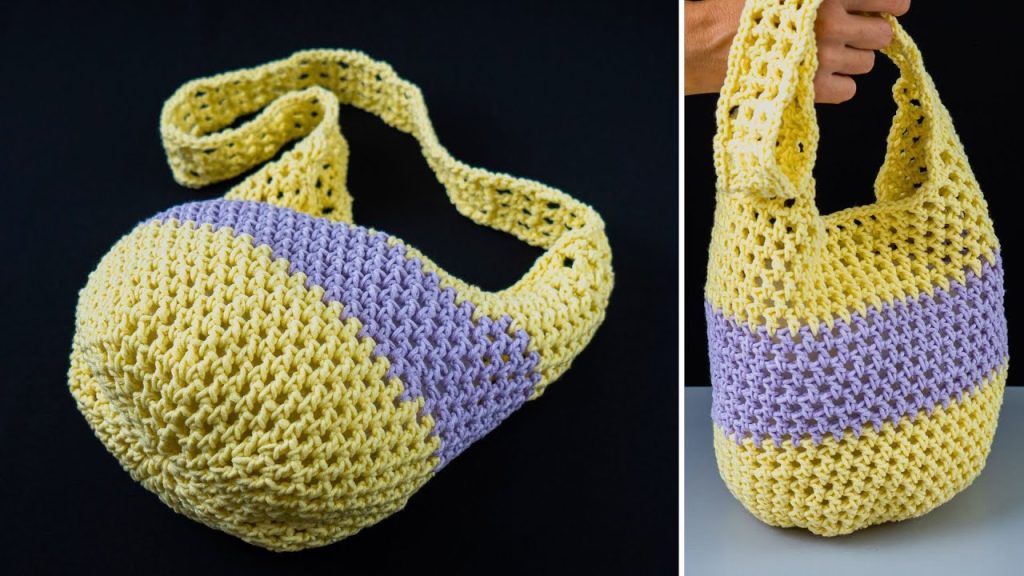
Let’s Crochet Your Easy Net Bag!
We’ll build this bag from the bottom up: starting with a solid oval base, then creating the open mesh body, and finally adding integrated handles.
Part 1: The Oval Base
You’ll create a flat, sturdy oval shape that forms the bottom of your net bag. We’ll achieve this by working single crochet stitches around a starting chain.
- Starting Chain:
- Make a slip knot with your yarn and place it onto your H/5.0mm crochet hook.
- Chain (ch) 21. (This length determines the initial width of your bag. If you want a wider or narrower bag, adjust this chain. It should be an odd number.)
- Round 1 (Working around the chain):
- Work 2 single crochet (sc) stitches into the 2nd chain from your hook.
- (Optional: Place a stitch marker in the first sc you just made. This will be the first stitch of your round for tracking.)
- Work 1 sc into each of the next 18 chains.
- In the last chain (the 21st chain from your hook): Work 4 sc into this single chain. This neatly turns the corner.
- Now, work back down the other side of your starting chain, into the bottom loops.
- Work 1 sc into each of the next 18 stitches.
- In the last stitch (the same chain where you placed your first 2 sc): Work 2 sc into this chain. This turns the other corner.
- You should now have a total of 44 sc stitches (2+18+4+18+2). Do NOT join with a slip stitch yet. For the base, you’ll work in continuous rounds (spirals) to avoid a visible seam.
- Round 2 (Continuing the Oval Shape):
- Work 2 sc into the first stitch of the round (where your stitch marker is).
- (If using, move your stitch marker to this new first sc of the round.)
- Work 1 sc into the next stitch.
- Work 1 sc into each of the next 18 stitches.
- Work 2 sc into each of the next 3 stitches.
- Work 1 sc into each of the next 18 stitches.
- Work 2 sc into each of the next 2 stitches.
- You should now have 50 sc stitches. Continue working in continuous rounds.
- Round 3 (Final Base Round):
- Work 2 sc into the first stitch of the round (where your stitch marker is).
- (If using, move your stitch marker to this new first sc of the round.)
- Work 1 sc into the next 2 stitches.
- Work 1 sc into each of the next 18 stitches.
- Work 2 sc into each of the next 3 stitches.
- Work 1 sc into each of the next 2 stitches.
- Work 1 sc into each of the next 18 stitches.
- Work 2 sc into each of the next 2 stitches.
- You should now have 56 sc stitches.
- Stop here! When you finish the last sc of this round, remove your stitch marker.
- Slip stitch (sl st) into the first sc of this round to join. This flattens the end of the round and prepares for working straight up the sides of the bag.
Part 2: Building the Mesh Body
Now, you’ll create the open, stretchy mesh pattern that gives the net bag its signature look. This is done using chain spaces and double crochet stitches.
- Round 4 (First Mesh Round):
- Chain 3 (ch 3 – counts as your first double crochet (dc)).
- Skip the next stitch.
- Work 1 dc into the next stitch.
- *Chain 1 (ch 1).
- Skip the next stitch.
- Work 1 dc into the next stitch.*
- Repeat from * to * around the entire round.
- After your last dc, chain 1, then slip stitch (sl st) into the top of the beginning ch 3 to join the round. (You should have 28 dc stitches and 28 ch 1 spaces).
- Rounds 5 and Onwards (Continuing the Mesh):
- Chain 3 (ch 3 – counts as your first dc).
- Work 1 dc into the first chain-1 space from the previous round.
- *Chain 1.
- Work 1 dc into the next chain-1 space.*
- Repeat from * to * around the entire round. You will always be working your dc stitches into the chain-1 spaces of the previous round.
- After your last dc into a chain-1 space, chain 1, then slip stitch (sl st) into the top of the beginning ch 3 to join the round.
- Repeat this round until your bag reaches your desired height for the mesh body (approximately 15-20 more rounds, or until it measures about 12-14 inches (30-35 cm) from the base).
- The beauty of this stitch is that it will stretch a lot when filled, so don’t be afraid if it looks a bit short when empty.
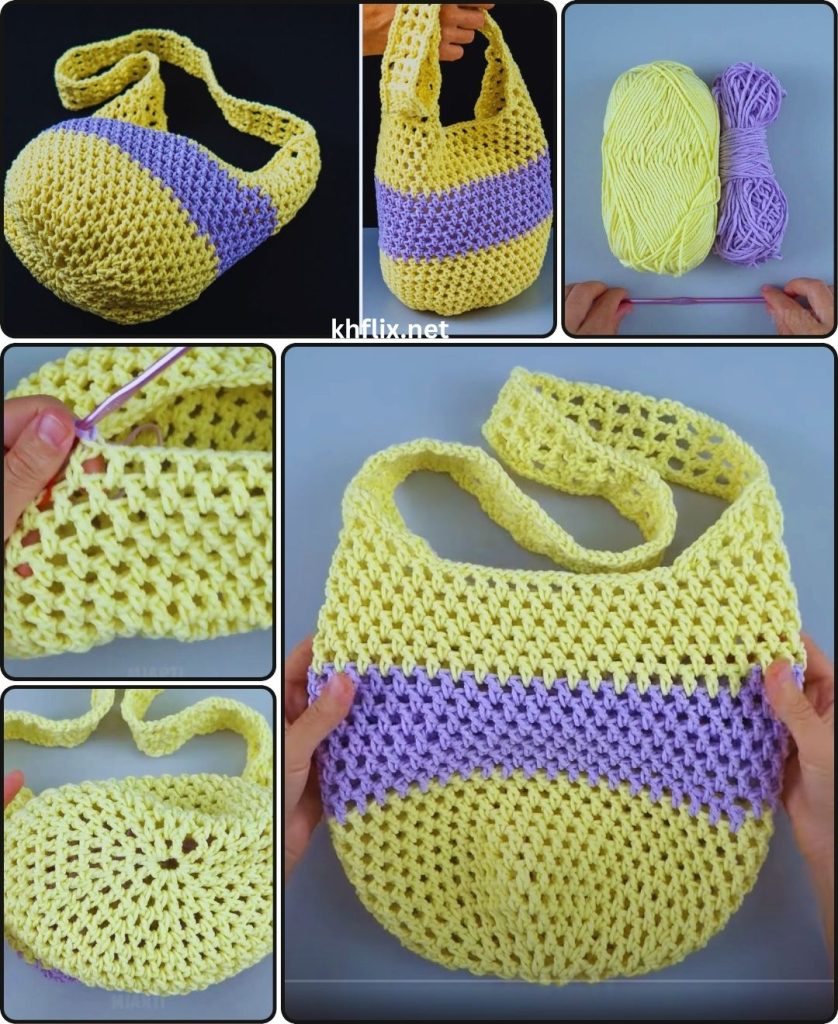
Part 3: Creating the Handles
The handles will extend directly from the top of your bag, using single crochet stitches for a strong and durable finish.
- Round for Handle Placement:
- After your last mesh round, chain 1 (ch 1 – does NOT count as a stitch).
- Work 8 single crochet (sc) stitches. (Work these into the dc stitches and chain-1 spaces from the previous round as evenly as possible).
- Chain 30 (ch 30 – this creates the length of your first handle. Adjust this number to make the handle longer or shorter for shoulder or hand carrying. For a very long crossbody, you might chain 50-60).
- Skip the next 12 stitches/spaces. (Count 12 dc/ch-1 space combinations as skipped. This creates the open space for the bag’s opening).
- Work 16 sc stitches. (Work these evenly across the next section, through dc stitches and chain-1 spaces).
- Chain 30 (ch 30 – this creates the length of your second handle).
- Skip the next 12 stitches/spaces.
- Work 8 sc stitches. (Work these evenly to bring you back to the start of the round).
- Slip stitch (sl st) into the first sc of this round to join.
- Round for Handle Strengthening:
- Chain 1.
- Work 1 sc into each of the 8 sc stitches from the previous round.
- Now, work 30 sc stitches around your chain-30 handle loop. Make sure to work directly into the chain itself, forming a solid handle.
- Work 1 sc into each of the 16 sc stitches between the handles.
- Work 30 sc stitches around the second chain-30 handle loop.
- Work 1 sc into each of the remaining 8 sc stitches.
- Slip stitch (sl st) into the first sc of the round to join.
- Fasten Off:
- Cut your yarn, leaving a 6-inch (15 cm) tail.
- Yarn over with your hook, pull the cut tail completely through the loop left on your hook, and gently tug to secure the knot.
Part 4: Final Finishing Touches
- Weave in All Ends:
- This is the most crucial step for a neat and professional-looking bag. You’ll have tails from your starting chain and the final fasten-off from the handle.
- Use your yarn needle to meticulously weave in every loose yarn tail.
- How to Weave Neatly: Thread the yarn tail onto your yarn needle. Weave the tail into the stitches of your bag. Go in one direction for at least 1-2 inches (2.5-5 cm). To truly secure it, subtly change direction (e.g., weave along a stitch, then turn and weave back through some of the same stitches diagonally or perpendicularly) to “lock” the tail in place and prevent it from unraveling. Trim any excess yarn close to the fabric, being careful not to cut any of your actual stitches.
- Blocking (Optional):
- While net bags are naturally stretchy, light blocking can help even out your stitches and set the shape.
- Method: Gently mist the bag evenly with cool water using a spray bottle until it’s damp but not soaking wet. You can stuff the bag lightly with tissue paper or a small towel to help it hold its intended shape while drying. Allow the bag to air dry completely and thoroughly in a well-ventilated area. This might take a day or two.
Congratulations! You’ve successfully crocheted your very own Easy Net Bag! This simple project is a fantastic accomplishment for any beginner, and you now have a sturdy, reusable, and stylish bag that’s perfect for all your summer adventures.
What will be the first thing you carry in your new net bag?

